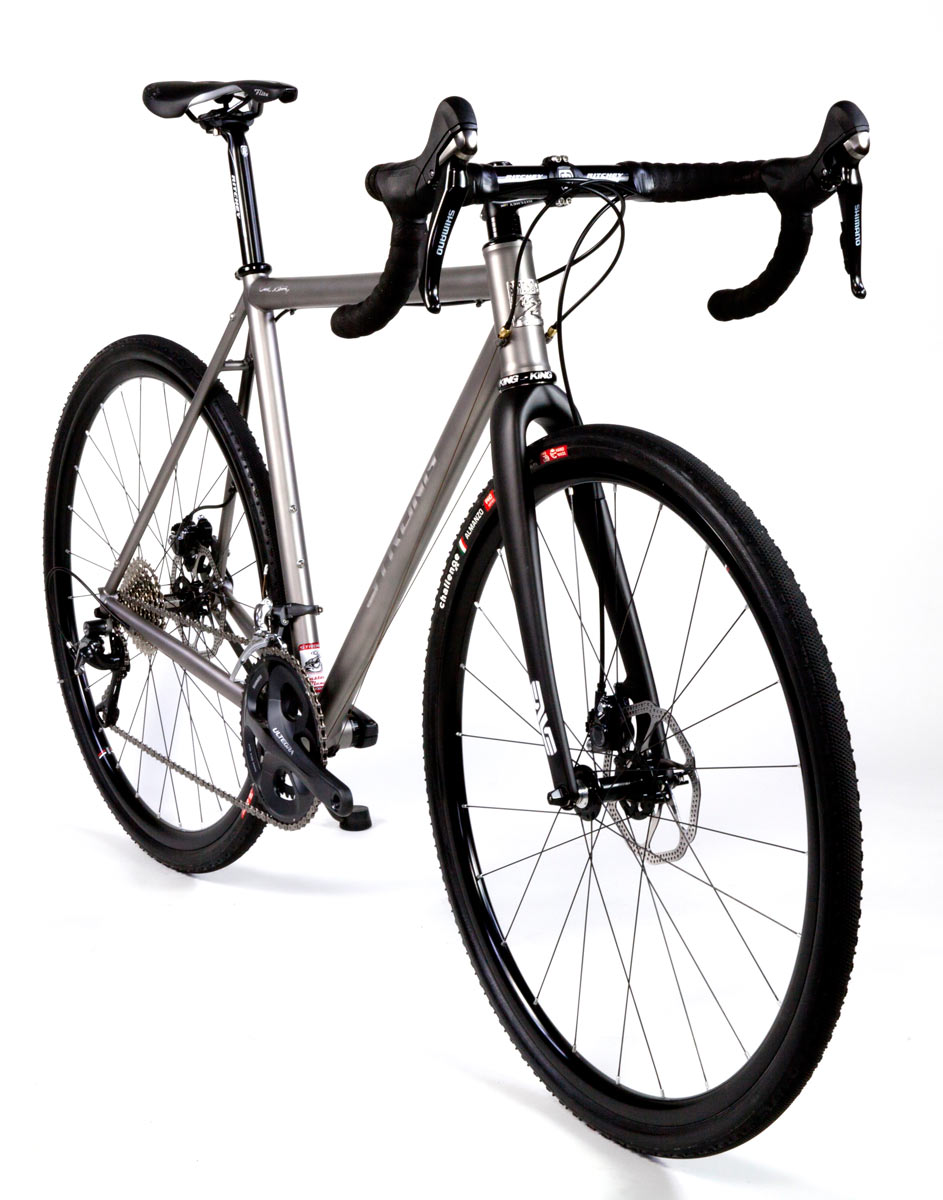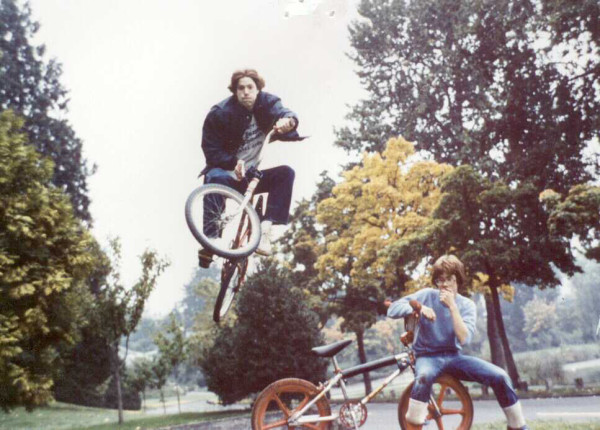
Strong Frames has gone through several phases in its over 20 year existence. It grew from a one man band in Carl Strong’s grandmother’s garage to a million dollar a year company with twelve employees at its largest. In the past ten years, however, the company has been poetically distilled down to its current, ultra-focused, customer-centric format.
Getting to do this interview was very exciting for me for a couple of reasons. For one, having spent my last few weeks interviewing builders and frame builder community members, Carl Strong’s name has come up quite a few times as someone who deserves accolades within the community for his work in helping new builders to get established and as someone who people have gone to for advice. For another, this interview was an opportunity to talk to the better half of Strong Frames, Loretta Strong, who is a massive reason why the company is the way it is today…
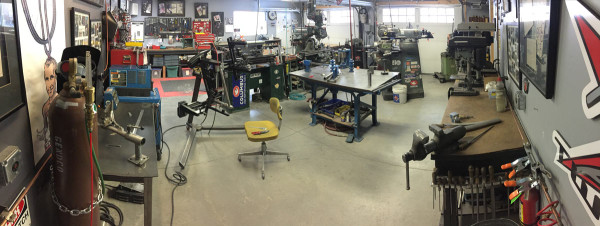
BIKERUMOR: What is the Carl Strong origin story?
CARL: When I was in college and couldn’t afford to buy good quality race bikes, at the time all race bikes were steel, I got the crazy idea that I would build bikes. Growing up, I had been a mechanic and had been through shop classes and knew all the basic skills, you know, welding, machining, brazing, finishing. It was also when the mountain bike boom was occurring, so TIG welded bikes were really common in mountain biking but were rarely seen in road biking, so I decided to bring that typical American TIG welded, sloping top tube style to my bikes at the time, and that’s how I kind of got started.
BIKERUMOR: What was your first bike?
CARL: TIG welded road bike.
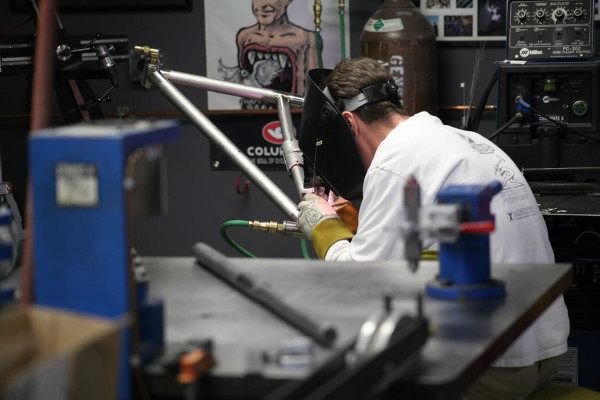
BIKERUMOR: I’ve talked to quite a few builders up until now and you’ve been really important to a lot of builders because of how conscious you are about turning building frames into a viable and supportive business – challenging the image of a solo builder, suffering and impoverished for his art? You have given your advice to everyone at this point. I called to John Caletti, for example, who is a big fan. When was the point where you decided to actually turn frame building into a business? And how has your experience inspired your push towards making building bikes sustainable economically?
CARL: I think pretty early on… I’ve always known, as long as I can remember, that I’ve never wanted to work for another person. I’ve never been an employee personality. At a very young age I decided that I was going to have a business. I guess I was at a certain point where, where this makes sense to be a frame builder. So I hung my shingle out pretty early, probably long before it should have been. The results of that, I had a lot of miserable early years in the business, there’s not a lot of other alternatives to that, really.
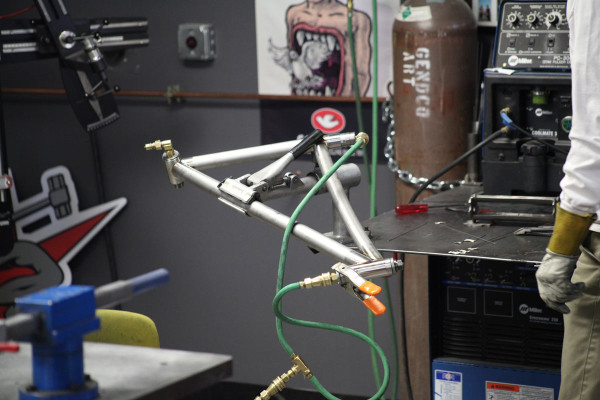
BIKERUMOR: Everyone has to go through that misery is what you’re saying.
CARL: Well, you know I don’t want to promote people who aren’t making safe products or good products to be out there selling sub-standard product, but at the same time, really the only way you can do this business right is to go work for a bigger company and learn all of the different processes. And even then, you only know how to build a frame. The business of frame building is 30% frame building and 70% running a business, which a lot of people don’t realize and they spend 90% learning how to build a frame and only 10% of their time learning how to build a business. They should match their efforts probably more closely to the demand that the activities put on you. Then we did, like, what every red blooded American person does which is grow the business. Grow grow grow grow grow. The bigger the better. It’s programmed into us by society. So we went all the way through that whole process. We tried a lot of different business models. We got the business pretty big, and we noticed that we had more risk, more responsibility, more people dependent on us, more stress, and we weren’t really making more money. So we paired it back down to one-builder shop, which is what we are now, got rid of a lot of risk. Got rid of a lot of the responsibilities. And actually, we make more money now than we ever did when we were a million dollar a year company.
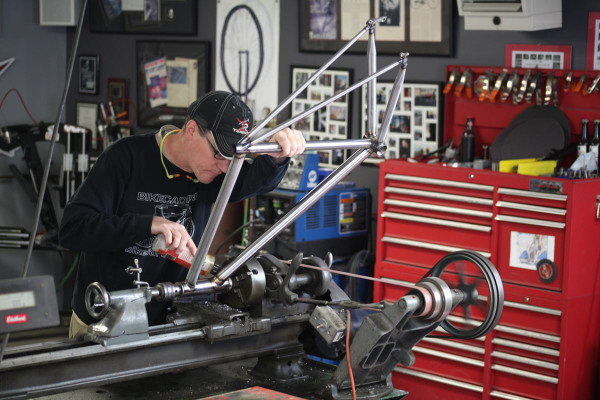
BIKERUMOR: When did you decide to shrink back down?
CARL: Probably in 2005?
BIKERUMOR: So you and Loretta were together at that point then.
CARL: Yes.
BIKERUMOR: Was this a mutual decision?
(At this point, I can hear Loretta laughing on the phone.)
CARL: If it’d been left up to me, I would have kept banging my head against the wall. But Loretta heavily encouraged us to cherry pick out the sweet spot, and get rid of the rest. And that’s what we did. And at the time, we also had an employee who was really really smart, and he kind of encouraged me to take Loretta’s lead on that. Between the two of them, I lost that battle.
BIKERUMOR: So modern Strong Frames is really a joint venture is what you’re trying to say. There is pre-Loretta and post-Loretta Strong.
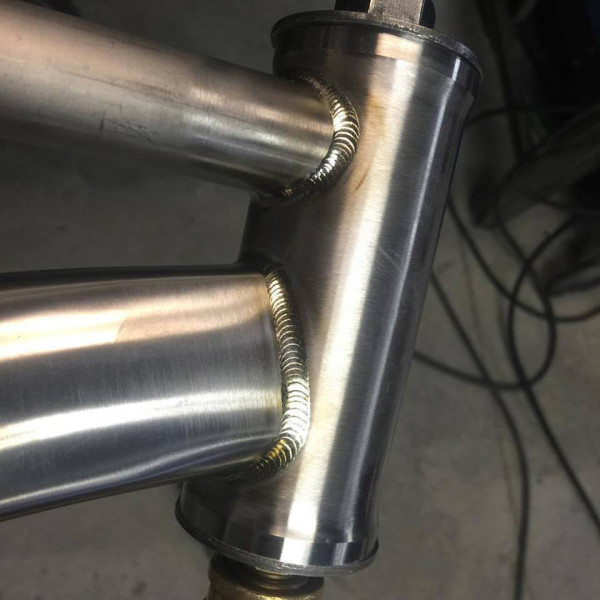
CARL: I’d never really thought about it that way. But yeah, there truly is.
BIKERUMOR: Loretta, within the context of the origin story of modern Carl Strong (’cause that’s what we’re talking about right?), how did you get involved here? Not a lot of – I’m not saying that dating frame builders or getting together with frame builders isn’t appealing, but it’s not an easy life.
LORETTA: That’s so funny. Well, I started out working for him. It was something that I knew I wanted to be a part of as far as the company was concerned, and I knew Carl from just working at bike shop and from people and friends. It got to a point for him where it wasn’t fun, it wasn’t enjoyable, and it was very obvious where we could make the money and where money obviously wasn’t being made. I think that if it was up to Carl, he would have continued with all the people and everything, but it was just too much, and so at the time we’d been married, it wasn’t something I wanted to see him do for a long time because he wasn’t really a frame builder anymore, he was training other people to do that for him, and he was miserable.
I was kind of encouraging him to go back to the bench and start being a frame builder. If we could cherry pick it down to building the kinds of bikes we wanted to build, and do more full built bikes, ‘cause at the time we weren’t building a lot full built bikes, then we started pushing custom paint jobs, and it got to a point where we could encourage our customers to be better customers. Then we didn’t have to do everything else. We didn’t have to make as many bikes. Carl needed to let go of the idea that we needed this huge business and a bunch of employees and all these people because everyone at the end of the day wanted to deal with Carl Strong, no one wanted to deal with our employees, so he was just being pulled in every direction. It wasn’t too hard to convince him…
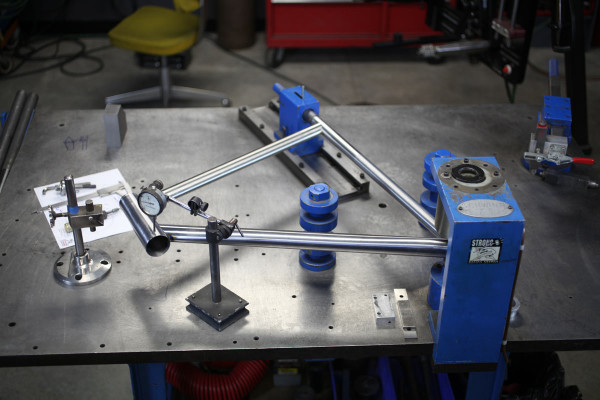
BIKERUMOR: You’ve gone through all these organizational phases. You grew and grew, changed facilities, reorganized, you were building for Ibis, you had a bike shop… how big were you when you were at your biggest? It’s interesting to see how your company has evolved, and I think that it’s harder to appreciate your current configuration without understanding exactly how much you focused in.
CARL: At our biggest, we were doing about a thousand bikes a year with twelve people. At one period, we were doing 70% private label, and between 250-275 Strong frames. When Ibis cratered, we got out of OE, we built a building, we moved into that building, we kept up a pretty high rate of Strong Frames, and then we opened a bike shop. The bike shop was horrible… oh man was it horrible. So then we closed the bike shop down after a couple of years, because trying to run a bigger business and be a frame-builder and then trying to manage a bike shop – it just became more work than could be done. And so I got to a point where the bike shop and the frame shop were suffering, I had to pick one. Obviously, I picked the frame building business – it’s way more profitable than a bike shop.
BIKERUMOR: But which one is more fun?
CARL: The frame building, for sure.
BIKERUMOR: So it wasn’t like there was a trade off. It was more “Why am I doing this?”
CARL: It was. Because we built our building in downtown and we thought, “Well heck, we’ll become a retailer. We’ll be a bike shop, it’ll be fun.” It actually made money.
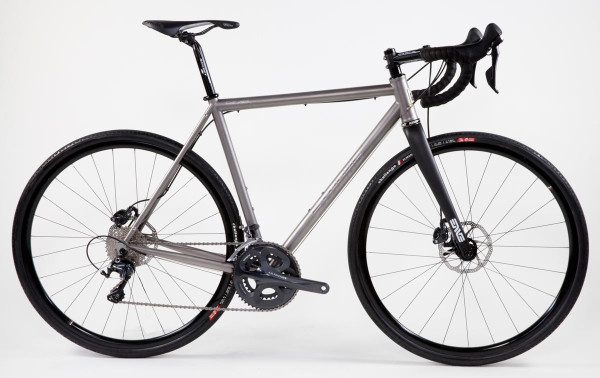
LORETTA: But it was a really big huge distraction to Strong Frames. People came in all the time and they’d want to lollygag all the time. And we were there to work. So it was a lot of juggling priorities. We would come in at 4 o’clock in the morning so we would have our work done by the time the store opened – we knew we couldn’t get it done during the day.
BIKERUMOR: I bet you attracted some gawkers.
CARL: There is a ton of different kinds of people, and then you’d be on the shop floor, maybe I’m trying to weld a frame or something, and a retail employee needs me or a retail customer wants to talk to me or maybe a manufacturing employee or maybe I needed to take a telephone call. If maybe I could have been completely a manager, it would have been a lot easier, but I didn’t find a way to replace myself on the shop floor, especially for welding, we tried to train somebody but we didn’t have a lot of luck. In a small town like this, there aren’t a lot of trained up welders, especially ones that will fit your culture.
BIKERUMOR: Your current operation is out of your garage, basically. It’s a really, really nice garage, but it’s literally your garage. It’s a bike a week.
CARL: Yeah, a bike a week. We built this garage specifically so we could operate a business in it. We do a bike a week. We try to send most bikes out as complete bikes – about 50 a year.
BIKERUMOR: So why a single bike a week? You’ve done bikes at such a high production level, it sounds like you could have the capacity to push more product through. Why are you deliberately keeping it on this level?
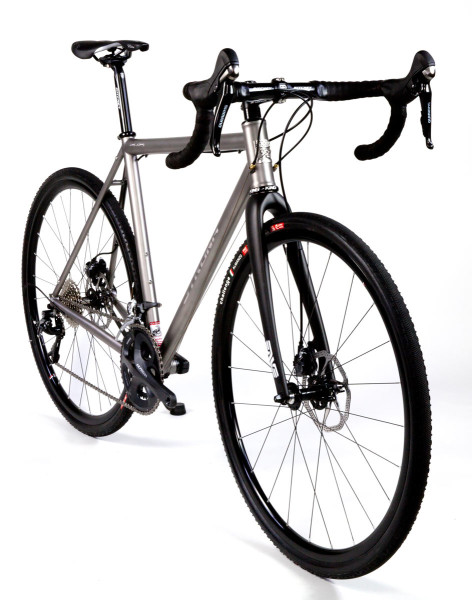
CARL: Batchwork is inefficient from a business management perspective. From a manufacturing comfort level, it feels good, like you’re saving some time. But ultimately you save very little time. You’re going to have to set everything up differently. But I could probably batch some sub assemblies. But then you’re investing time and money into product that you can’t turn into revenue until a later date. You have to have working capital to represent that input and there’s just no reason to have that working capital tied up in a bunch of half built frames on the wall when I can take that money and invest it in ways that give me a higher rate of return. So that’s just purely a business decision. If I just do one bike a week, I can really focus on that customer, because my relationship with that customer and my relationship with building that one person’s bike is part of the value that I have. So when I pull their file and when I pull their box of tubes, I’m there for that whole week building the bike, assembling the bike, ordering parts, ordering materials, every little aspect of it is for them. And when you pay that much attention to an individual transaction, you can charge a premium for it, frankly, because you’re giving added value.
BIKERUMOR: What’s the exciting thing for your current format, for both of you? You’ve been talking about things in these quantifiable business terms, but what’s exciting about it for you?
CARL: Well for me what’s exciting about it is that we’re working at a very comfortable rate of speed. We can get everybody the attention they need, as much attention as they want. The other part of it is we can pay attention to details, things don’t slip through the cracks. Also, our day to day activities vary so much. One day could be customer interaction and another day could be frame building. Another day could be working on marketing or working on our finances, so it’s a broad range of activities and it keeps it interesting. That’s what I kind of like about it, the calm, slow deliberate pace and enjoying the different aspects of the business at different times so it doesn’t get boring.
BIKERUMOR: And you, Loretta? What’s exciting about this current phase of the business for you from where things were before?
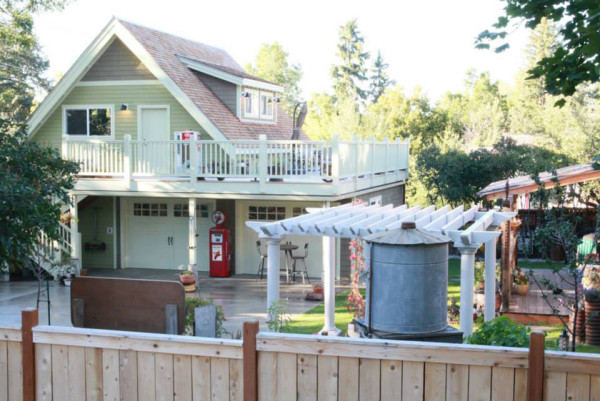
LORETTA: I think – I feel like we do have more time and energy to put into more fun parts of the business. We ride more. There was a time when we couldn’t leave the shop because… you couldn’t. And now if it’s nice out and we want to go for a ride, we just shut it down and go for a ride. It gives us more flexibility. It gives us more time to interact with our customers so we get to know them better. A lot of them come and visit and go for rides for us. It’s a little bit more personal as an experience, I think. It’s nice to not have to commute. Just working from home is very nice. I think a lot of people would get distracted working from home, but when you come into the shop during the day, it’s for working, and when you go in the house during the day it’s for coffee or the bathroom. We don’t get distracted by the house so much. I get a little distracted with my garden in the summer, but everyone really likes it, so I call it part of the business. Having a nice patio and garden for people to hang out at. It’s really nice.
BIKERUMOR: I’m talking to a lot of builders. A lot of them are talking about following a similar arc to you. Like, they want to grow, they want to hire a bunch of people. They want to broaden their impact. They want to put more bikes out there. What is the advice you give these people, who seem to be following this path?
CARL: Well I think there just seems to be this foregone conclusion that that’s the path you need to follow. Like I said earlier, it’s bred into us, right? The question is: what’s the person’s goal? Is the goal to make more bikes? Is it to have a broader impact? Is it to make more money? Because ultimately you can look at all these businesses that you hold out to be these models of success but a lot of them don’t make a lot of money. Or they look great from the outside… but the business model is hard because what people are trying to get at – people are trying to build a scaled business model with a product that’s not a scale-able product.
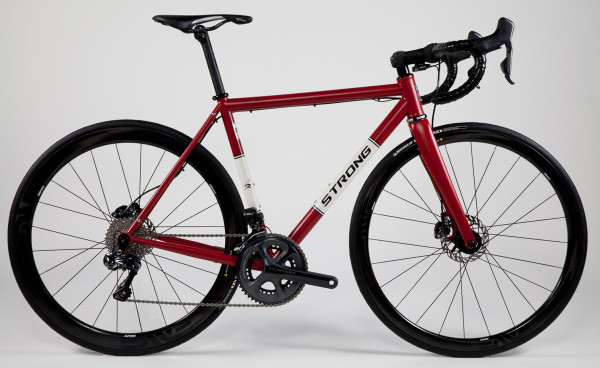
BIKERUMOR: Yes. Exactly.
CARL: And so, what you have to do is you have to decide that you scale the product, or you don’t scale the business. So you get these people who get stuck in no man’s land. That’s what I’ve found. You’re at a cross road. I have more work that I can do, I need to hire a person. So that’s one fork in the road. The other one is raise your prices until the demand goes down. That’s the other fork in the road. I took the first fork based on this idea that I wanted to be Serotta or Indy Fab or somebody. Turns out Serotta’s bankrupt and who knows about Indy Fab.
You gotta think about what your goals are and learn about business and business models. Learn what a business model is, and learn how to make a business model.
LORETTA: I think that being someone who actually works in the shop with Carl and a lot of wives are very involved. John [Caletti’s] wife Cory is very involved and Misty is very involved with Curtis, they don’t truly work the day-to-day operations with them, and you learn that their personalities are very similar. They work alone for a reason. They don’t realize what the management needs to be, and it’s not necessarily the fun part of what they are trying to do. And a lot of them learn that from each other. They all have similar personalities. None of them are trying to punch a clock. They are trying to just do what they do and love it, and do it the way they love to do it, and learn as much as they can about it and each other. It’s kind of a cool industry because they do have that brotherhood about them.
BIKERUMOR: You must have just been such a breath of fresh air in this situation. You come in, and everything is fun, Carl’s like slaving away, you’re like “This could be great. Why aren’t you happy?”
LORETTA: Yeah. All this stuff, I was just kind of used to. And going to the show, it was a lot of fun, just getting to know all the different builders. And when NAHBS first started and it was a very small group of a lot of the old school gang of frame builders, everybody really truly got to know each other and appreciate each other, and respect each other’s skillsets, and it was a fun time in the industry. It still is, the show’s gotten so big that you lose a lot of that feel, but at the same time, you go to our show, and it doesn’t feel like a trade show. It feels like you’re at a festival of some sort and it’s because everyone is so friendly with each other. They aren’t competitive in that sense that they won’t walk into each others’ booth and have a good time.
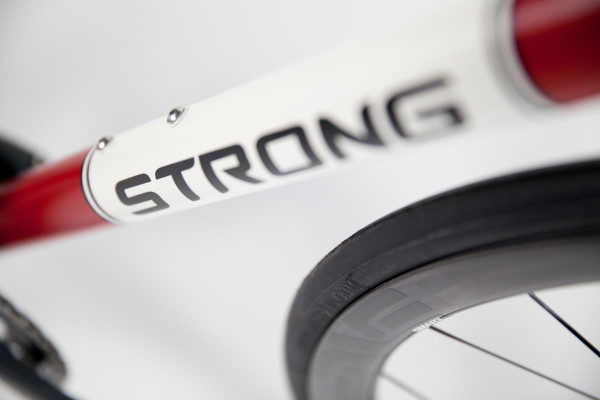
BIKERUMOR: That’s something really cool that Don Walker said, is that at the end of the day, you aren’t competing with each other so much as you are collectively competing for a larger piece of the pie occupied by the larger brands.
LORETTA: And that’s a big reason why Carl puts on the business seminar. The better each small brand is, the better it is for our niche. We can’t be in it alone because we are standing up to large companies like Specialized or Trek. If our customers don’t get as good of an experience from all of us, then we don’t get that market share because people lose faith in what we’re doing. So we all need to do it at the best possible level to keep our customers coming back for more.
CARL: That makes me think of something too, Anna, because part of that business seminar I do is – one of the reasons is there are a number of us builders and we all have to split up this market. When guys are trying to grow their business and they want to build 200-300-500 bikes, what they have to – you can build a business that makes 400 bikes a year, and maybe you’ll make $80-90-100,000 a year, or you can build 50 bikes a year, and make the same income or more. If everybody focused on actually being a custom builder, and custom building, and not trying to morph themselves into a manufacturer, there would be more business to go around and customers would end up with a better product, because builders would be making better product with better attention to detail. I kind of think this whole idea of growing these custom frame shops – there are a few people out there who are going to make it work but they are the exception to the rule, and so I don’t want to discourage anybody who’s really ambitious and really wants to do it, but I do want to open people’s eyes to the fact.
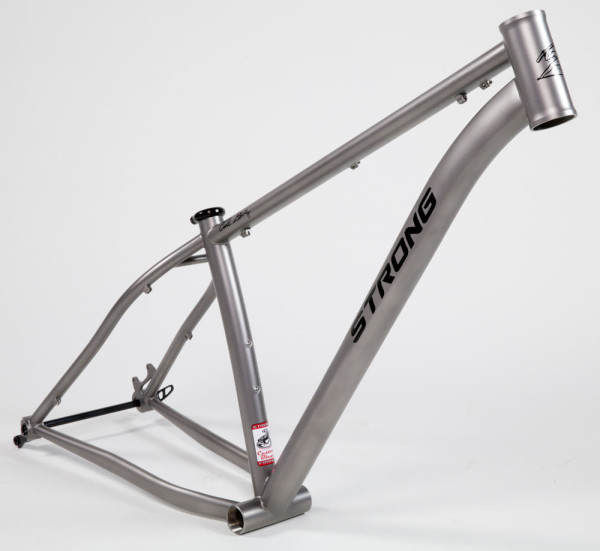
And nobody is paying any attention to the opportunity. They are looking right over the opportunity and they are looking at this preconceived idea that is bred into us. And so the obvious model is sitting right there. I tell people build your company, turn it into a profitable shop. Set a goal. When you reach that goal and you still want to be a bigger, launch from there. But what everybody does is that they don’t make any money, or very little money, and they think they need to do more sales in order to hit some point of profitability but what happens is the fixed overhead curve is parallel to the income curve, and they both go up at the same time, and you never make any more money. First thing is you need to learn how to be profitable, and then you can grow. But everyone is doing it backwards. And basically, when you get profitable and make $100k a year, you may just want to stay there and, you know, go for a ride in the middle of the day.
BIKERUMOR: No illusions as to why John Calletti likes to call you up to chat, then. So what can people expect from you at NAHBS this year?
CARL: The same thing that they can expect from me every year. So you know why I go to the show is so I can talk to people. I only bring a bike or two because I need to be able to show the work. The most important part of the show is just engaging with people. The frames are just sort of there as a backdrop. What I bring in any year, I bring an example or two examples of what I’ve built the most of. This year, I’m bringing two gravel bikes. One is a little more towards the monster cross end of the spectrum, and the other is more towards the road end of the spectrum. And then a fat bike. And that’s it. They’re going to be nice bikes. There’s nothing that really sets the world on fire. When your customers buy custom frames, I think they are really buying the frame building. I see our business as a service business, so the bikes we build are the deliverable but ultimately, they are buying me and the confidence that I’m going to meet their goals and priorities in some professional, reliable manner. So I’m there to meet people and the press. I understand that I get overlooked a lot, especially just being around so long. I’m not interesting or new. My bikes aren’t interesting or new. It takes a lot of self-control to resist the temptation to try to do something crazy, and again, at the end of the day, though, you’ve got to be true to who you are and you can’t try to be something you’re not. So I’m just sort of toeing the line.
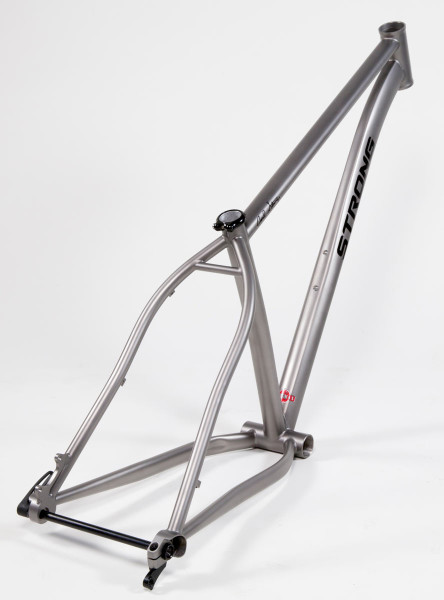
LORETTA: Just like Carl, he toes the line.
CARL: Loretta calls me a “fun hater.”
BIKERUMOR: What’s the advice that you give people walking the show?
LORETTA: I used to love when there was the show guide because you could get it and kind of get all the personalities from that one guide instead of having to step in their booths and having to get to know every one of them. I think that’s the thing about the show – the majority of it is custom, hand-crafted work. And that’s what you should be there to see, is that work and all the uniqueness of all the different builders. In reality, each separate bikes is a reflection of the person who built it. That’s the cool part of the show is you can see where a person like Kevin Harvey’s interests lie, and you can see where a person like Curtis Inglis’ interests lie just by looking at the bikes they build. I think that is part of the experience that consumers should have. Also, a lot of the consumers who go to the show are collectors of bikes, and they like that different unique experience that every builder offers, to them it makes them part of the community that they want to invest in, and it shows them that we are a community. Like “oh man, I didn’t know you knew so and so, I own one of his bikes too. I wouldn’t have told you if you hadn’t said you were friends.”
CARL: To add to that also, and to add to what you were saying about appreciating bikes that aren’t wow-in-your-face show bikes is if you engage the builders and ask them about those bikes rather than looking at them and making assumptions, there could be a thousand little things that that builder really cared about that you would never notice unless you gave them the opportunity to introduce you to them.
